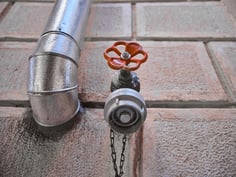Pipes Sweaty?
It may be hard to believe, but your sweaty pipes aren’t a sign of a leak in most cases. True sweating comes from a different source altogether. However, the moisture that accumulates on the outside of a pipe still causes the same problem as any leak, including mold growth and rot. Solving the pipe sweat problem will help dry up your basement or crawl space. It simply requires an understanding of insulation and condensation concepts as they apply to home plumbing.
Why Do Pipes Sweat?
The same condensation issue that causes your cold drink to sweat on the glass and leave a ring on the table leads to sweaty pipes. The contrast between warm and humid air from summer conditions and the cold surface of a cold water pipe leads to the condensation of water on the surface. It can drip off and accumulate under the house, inside the walls, and even inside the attic, depending on how your plumbing is laid out. The water on the pipe comes from the air itself, not the pipe. A plumber can determine with dye testing or just a physical inspection if you're dealing with a leak or condensation. Sweaty pipes aren't a serious issue at first, but they'll lead to long-term problems if they're not insulated.
ring on the table leads to sweaty pipes. The contrast between warm and humid air from summer conditions and the cold surface of a cold water pipe leads to the condensation of water on the surface. It can drip off and accumulate under the house, inside the walls, and even inside the attic, depending on how your plumbing is laid out. The water on the pipe comes from the air itself, not the pipe. A plumber can determine with dye testing or just a physical inspection if you're dealing with a leak or condensation. Sweaty pipes aren't a serious issue at first, but they'll lead to long-term problems if they're not insulated.
How to Solve the Pipe Sweating Problem
One way to prevent pipes from sweating is to air conditioning or heat all of the spaces where the cold water pipes run. In most homes, that's not a practical solution to the problem. A more adaptable approach is insulating the pipe with foam wrap. A foil or plastic tape may also be recommended to protect the foam from damage and increase its insulation value. Wrapped pipes won't get sweaty, so if you still see leaks or moisture after this point, you have a leak elsewhere in the plumbing. Don't let moisture issues continue regardless of the cause since all excess moisture in a home will eventually lead to mold or mildew.
Should You Dry Out the Pipes?
Before applying any insulation or having the plumbing professionally insulated, it's important to dry out the moisture issue. Dehumidifiers and space heaters reverse condensation issues by drying the air as well as moisture that has dripped on the walls or floors. It may be necessary to open up a wall or floor cavity to expose wet areas for thorough drying. Even in the most extreme cases of sweating pipes, the moisture shouldn't be so bad that water restoration services are needed. Mold treatment is recommended if any have already developed from the excess moisture. The pipes themselves may need to be wiped down with rags or shop towels before insulation is applied. Drying up the condensation also helps eliminate any potential of leaks by revealing where moisture returns immediately upon drying. Condensation takes at least a few hours to return to a dripping point, even in very humid conditions.
Solve your sweaty pipe problems by ideally applying insulation during the winter or spring before the condensation begins for the year. This eliminates the need to dry out the pipes and allows you to focus on mold or moisture remediation instead. If you have what appears to be sweat on the pipes in the winter, look for leaks instead.
